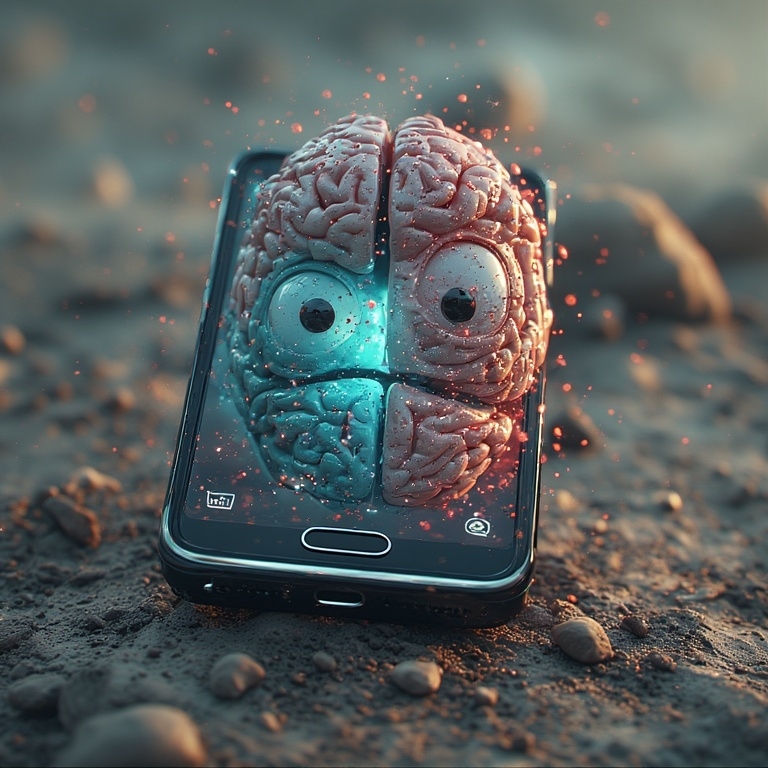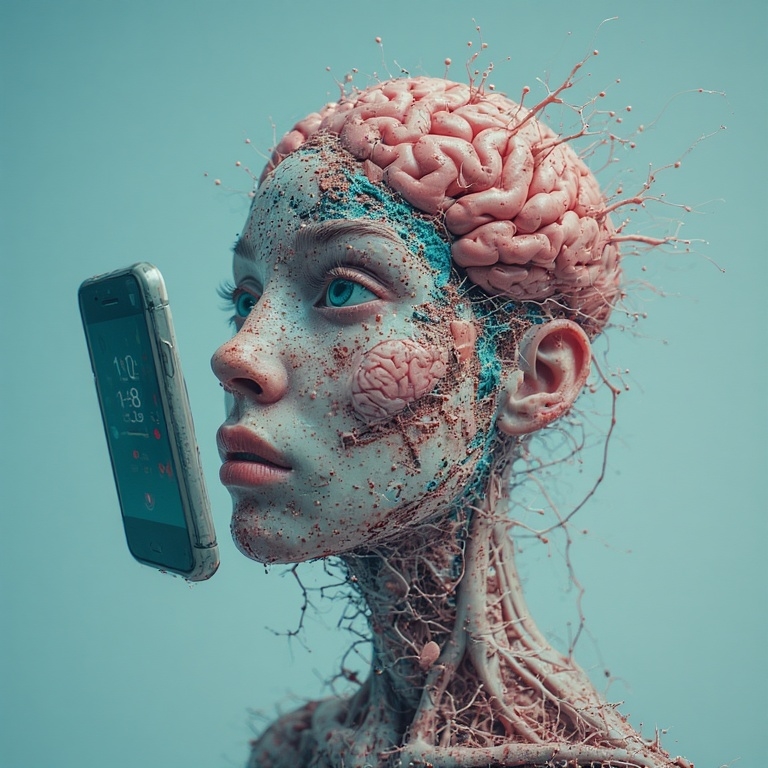
Fragmented Attention
The Psychology of Mobile Phones & Devices – How Devices Shape Our Minds and Behaviors
Mobile phones have become psychological companions, not just communication tools. Their presence influences how we think, feel, behave, and relate to others. The goal of how devices and mobile phones interact with the human psyche.
Mobile Phones as Mental Extensions
Mobile phones act as external memory banks, storing names, dates, and decisions we once held in our minds. This shift changes how we process information, making the device a cognitive partner. Instead of remembering facts, we remember where to find them. This reliance alters our mental habits, encouraging quick access over deep recall. The phone becomes a thinking tool, shaping how we approach problems and decisions. It influences our sense of control, offering instant solutions that bypass reflection. Over time, this changes how we value effort and patience. The device becomes a shortcut to knowledge, but also a filter through which we experience the world. It’s not just a tool—it’s part of our mental landscape.

Reward Loops and Habit Formation
Every notification carries the potential for reward, creating a loop of anticipation and response. This cycle reinforces frequent checking, even when no meaningful content appears. The unpredictability of alerts makes them more compelling, drawing attention away from other tasks. Over time, this pattern becomes habitual, shaping how we allocate focus. The phone becomes a source of stimulation, even in moments of boredom. This constant engagement rewires behavior, making silence feel uncomfortable. The device becomes a companion in idle moments, offering a sense of activity without purpose. These loops are not accidental—they are designed to keep users engaged. The result is a behavioral rhythm built around the device’s signals.
Fragmented Attention and Mental Drift
Mobile phones encourage rapid shifts in focus, breaking tasks into fragments. Each interruption pulls the mind into a new direction, leaving traces of unfinished thoughts. This fragmentation reduces the ability to concentrate deeply, making sustained effort more difficult. The brain adapts by favoring short bursts of attention over long periods of focus. This shift affects productivity, creativity, and emotional regulation. The phone becomes a source of mental drift, guiding the mind away from presence. Even when not in use, its potential to interrupt shapes how we think. The result is a scattered mental environment, where clarity competes with distraction.
Emotional Soothing and Avoidance
Phones often serve as emotional buffers, offering distraction during discomfort. This habit can reduce the ability to process feelings directly, replacing reflection with avoidance. The device becomes a shield against anxiety, sadness, or boredom. Over time, this pattern weakens emotional resilience, making it harder to sit with difficult emotions. The phone offers relief, but not resolution. It becomes a tool for escape, not healing. This dynamic is subtle but powerful, shaping how we cope with stress. The device becomes a comfort object, always within reach. Its presence offers reassurance, even when no solution is available.

Identity and Social Comparison
Mobile phones connect us to curated versions of other people’s lives, encouraging comparison. This exposure shapes how we see ourselves, often through the lens of inadequacy. The device becomes a mirror, reflecting idealized images that distort reality. Identity becomes performative, shaped by visibility and approval. The phone encourages presentation over authenticity, guiding behavior toward external validation. This shift affects self-esteem, especially in moments of vulnerability. The device becomes a stage, where likes and comments measure worth. Over time, this changes how we define success, beauty, and belonging. The phone becomes a filter through which identity is constructed.
Sleep and Mental Recovery
Using mobile phones before sleep disrupts the natural rhythm of rest. The light and stimulation delay relaxation, making it harder to transition into sleep. The device becomes a barrier to mental recovery, keeping the brain active when it needs to unwind. This interference affects mood, memory, and energy. The phone’s presence in the bedroom changes the environment, replacing calm with engagement. Even passive scrolling can delay sleep, creating a cycle of fatigue and distraction. The device becomes part of the bedtime routine, but not always in a helpful way. Its influence extends into dreams, shaping how the mind processes the day.
Sensory Conditioning and Phantom Signals
Many users report feeling their phone vibrate when it hasn’t. This phenomenon reflects how deeply the device embeds into sensory awareness. The brain begins to anticipate signals, interpreting unrelated sensations as phone activity. This conditioning shows how the device becomes part of bodily experience. The phone’s presence is felt even when absent, shaping perception. This response is not imagined—it’s a learned reaction. The device becomes a sensory anchor, influencing how we interpret touch and sound. Over time, this conditioning reinforces the phone’s role as a constant companion. It becomes part of how we feel the world.
Fear of Missing Out and Social Anxiety
Mobile phones keep us connected to a stream of updates, creating a sense of urgency. The fear of missing something important drives frequent checking, even during meaningful moments. This anxiety shapes behavior, making presence feel incomplete without digital awareness. The device becomes a portal to elsewhere, pulling attention away from the here and now. This dynamic affects relationships, focus, and peace of mind. The phone offers connection, but also pressure. It becomes a source of tension, balancing curiosity with overwhelm. The fear of missing out is not just social—it’s existential. The device becomes a lifeline to relevance.

Digital Isolation and Emotional Distance
Despite their promise of connection, mobile phones can create emotional distance. Users may be physically present but mentally elsewhere, focused on the device. This “absent presence” reduces the quality of interaction, replacing depth with distraction. The phone becomes a barrier to intimacy, even in close relationships. Over time, this pattern weakens bonds, making connection feel shallow. The device offers access to many, but closeness to few. It becomes a substitute for presence, guiding attention away from shared experience. This isolation is subtle, often masked by activity. The phone becomes a companion, but not always a friend.
Self-Regulation and Impulse Control
Mobile phones challenge the ability to delay gratification. The instant access to stimulation weakens impulse control, making it harder to resist distraction. The device becomes a test of discipline, often winning. This dynamic affects decision-making, focus, and emotional maturity. The phone offers immediate reward, bypassing effort. Over time, this shapes behavior, favoring quick fixes over long-term goals. The device becomes a source of temptation, always within reach. Managing its influence requires conscious effort and boundaries. The phone is not just a tool—it’s a challenge to self-control.
Narrative Disruption and Memory Fragmentation
Mobile phones interrupt the flow of experience, breaking life into snapshots. This fragmentation affects how we remember events, often reducing coherence. The device becomes a filter, shaping what we notice and record. Over time, this changes how we construct personal narratives. The phone encourages documentation over reflection, guiding memory toward images and captions. This shift affects identity, making stories feel scattered. The device becomes a curator of moments, but not always a keeper of meaning. It shapes memory, but also distorts it.
Design Psychology and Behavioral Influence
Mobile phones are designed to capture attention, using colors, sounds, and movement to guide behavior. These design choices exploit psychological tendencies, encouraging engagement. The device becomes a behavioral environment, shaping choices through interface. Over time, users adapt to these cues, forming habits around design. The phone’s layout influences how we think, scroll, and respond. It becomes a map of behavior, guiding action through subtle signals. This influence is not neutral—it’s intentional. The device becomes a behavioral architect, shaping experience through design.

Emotional Attachment and Object Bonding
Many users feel emotionally attached to their phones, treating them as companions. This bond reflects the device’s role in daily life, offering comfort and connection. The phone becomes more than an object—it becomes part of the self. This attachment affects how we respond to loss, damage, or separation. The device holds memories, messages, and meaning. It becomes a container for identity and emotion. Over time, this bond deepens, making the phone feel irreplaceable. The device becomes a symbol of connection, safety, and self.
Cultural Rituals and Symbolic Presence
Mobile phones shape cultural rituals, from morning routines to social gatherings. Their presence influences how we mark time, share experiences, and express values. The device becomes part of ceremony, guiding behavior through habit. It shapes how we celebrate, mourn, and communicate. The phone’s role in culture reflects its psychological power. It becomes a symbol of modern life, embedded in tradition. Over time, this presence becomes normalized, shaping expectations. The device is not just used—it is honored, feared, and relied upon.

Conclusion
Mobile phones are psychological ecosystems, shaping thought, emotion, and behavior in profound ways. Their influence extends beyond utility, embedding into identity, memory, and culture. Understanding this impact allows for more conscious engagement, balancing benefit with awareness. The device is not neutral—it is a mirror, a magnet, and a map. Its presence demands reflection, not just use. By exploring its psychological dimensions, we reclaim agency in a world of constant connection.
Join the Discussion
How has your mobile phone shaped your thinking or emotional habits? What boundaries help you stay present?
#MobilePsychology #DigitalMind #AttentionEconomy #EmotionalDesign #IdentityInTech #PhoneHabits #CognitiveExtension #DigitalSelf #SymbolicDevices #TechAndEmotion #PresenceMatters #MindfulTech







1 thought on “How Scary Devices Shape Our Minds and Behaviors”